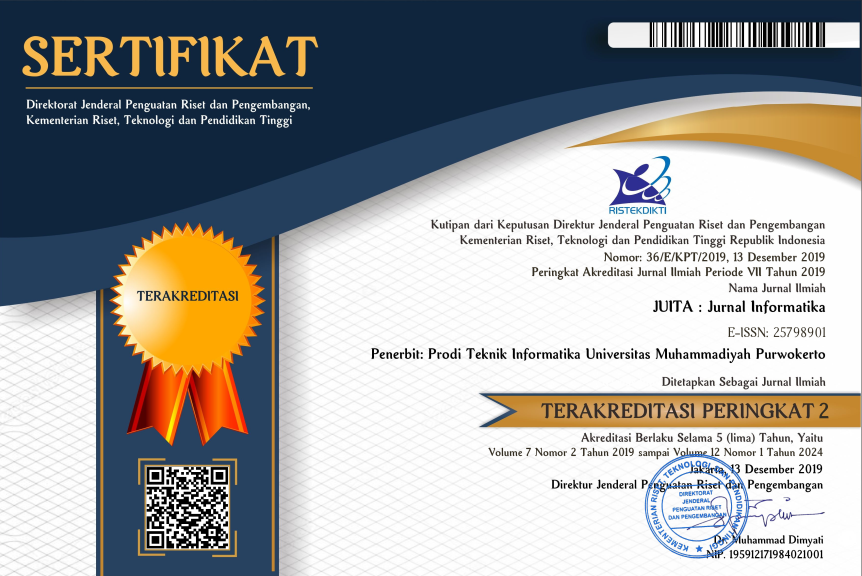The Automatic Classification System for Academic Performance Evaluation at the Faculty of Information Technology Atma Jaya University of Makassar
DOI:
https://doi.org/10.30595/juita.v11i1.14116Keywords:
Naive Bayes Classifier, Sastrawi library, evaluation system, academic performanceAbstract
Abstract - The Faculty of Information Technology currently carries out performance evaluations at the end of each semester and involves students as sources of data evaluation. The evaluation activity took place online on the website ss.fti.uajm.ac.id. With the number of active students, the number of evaluations that need to be read and the number read by faculty stakeholders also increases. This is inversely proportional to the time that stakeholders need time to read, evaluate, and categorize comments entered by students as part of the performance evaluation. In this study, a multi-classification of student comments related to evaluations at the Faculty of Information Technology UAJM will be carried out. Text pre-processing will use the Sastrawi library which includes stopword removal, stemming, and transformation of text into TFIDF form. The results of the pre-processing text will be used as input on Naive Bayes and using three scenarios to evaluate the classifier model. The average accuracy values of the Naive Bayes algorithm for category and sentiment labels are 79% and 81%, respectively. Furthermore, the expected result of this research is to reduce the time for FTI UAJM stakeholders to read and comment/suggest faster because the evaluation results are obtained in real-time.
References
[1] F. Handayani and S. Pribadi, “Implementasi Algoritma Naive Bayes Classifier dalam Pengklasifikasian Teks Otomatis Pengaduan dan Pelaporan Masyarakat melalui Layanan Call Center 110,” J. Tek. Elektro, vol. 7, no. 1, pp. 19–24, 2015, doi: https://doi.org/10.15294/jte.v7i1.8585.
[2] O. Arifin, “Sistem Klasifikasi Berita Daring Faktor Kejahatan Penyalahgunaan Narkotika Berbasis Algoritma Naive Bayes,” Telematika, vol. 11, no. 2, p. 27, 2018, doi: 10.35671/telematika.v11i2.713.
[3] T. H. Apandi and C. A. Sugianto, “Algoritma Naive Bayes untuk Prediksi Kepuasan Pelayanan Perekaman e-KTP,” JUITA J. Inform., vol. 7, no. 2, p. 125, 2019, doi: 10.30595/juita.v7i2.3608.
[4] A. Deolika, K. Kusrini, and E. T. Luthfi, “Analisis Pembobotan Kata Pada Klasifikasi Text Mining,” J. Teknol. Inf., vol. 3, no. 2, p. 179, 2019, doi: 10.36294/jurti.v3i2.1077.
[5] M. A. Rosid, A. S. Fitrani, I. R. I. Astutik, N. I. Mulloh, and H. A. Gozali, “Improving Text Preprocessing for Student Complaint Document Classification Using Sastrawi,” IOP Conf. Ser. Mater. Sci. Eng., vol. 874, no. 1, 2020, doi: 10.1088/1757-899X/874/1/012017.
[6] R. M. Chezian and C. Kanakalakshmi, “Performance Evaluation of Machine Learning Techniques for Text Classification,” in UGC Sponsored National Conference on Advanced Networking and Applications, 2015, no. March, pp. 53–57.
[7] N. Nagajothi and A. R. Nadira Banu Kamal, “Analysing performance of text classification models for sentiment analysis of movie reviews,” Int. J. Sci. Technol. Res., vol. 9, no. 2, pp. 3788–3791, 2020.
[8] H. Irsyad and M. R. Pribadi, “Klasifikasi Opini Terhadap Pertanian Sawit (Palm Oil) Indonesia Menggunakan Naïve Bayes,” JATISI (Jurnal Tek. Inform. dan Sist. Informasi), vol. 6, no. 2, pp. 230–239, 2020, doi: 10.35957/jatisi.v6i2.182.
[9] I. Y. Anggraini, S. Sucipto, and R. Indriati, “Cyberbullying Detection Modelling at Twitter Social Networking,” JUITA J. Inform., vol. 6, no. 2, p. 113, 2018, doi: 10.30595/juita.v6i2.3350.
[10] E. A. Lisangan, A. Gormantara, and R. Y. Carolus, “Implementasi Naive Bayes pada Analisis Sentimen Opini Masyarakat di Twitter Terhadap Kondisi New Normal di Indonesia,” KONSTELASI Konvergensi Teknol. dan Sist. Inf., vol. 2, no. 1, pp. 23–32, 2022, doi: 10.24002/konstelasi.v2i1.5609.
[11] M. Ridwan, H. Suyono, and M. Sarosa, “Penerapan Data Mining Untuk Evaluasi Kinerja Akademik Mahasiswa Menggunakan Algoritma Naive Bayes Classifier,” Eeccis, vol. 7, no. 1, pp. 59–64, 2013, doi: 10.1038/hdy.2009.180.
[12] E. Prasetyowati and N. Ramadhani, “Sistem Evaluasi Dan Klasifikasi Kinerja Akademik Mahasiswa Universitas Madura Menggunakan Naive Bayes Dengan Dirichlet Smoothing,” JUTI J. Ilm. Teknol. Inf., vol. 16, no. 2, p. 192, 2018, doi: 10.12962/j24068535.v16i2.a688.
[13] R. Rachmatika and A. Bisri, “Perbandingan Model Klasifikasi untuk Evaluasi Kinerja Akademik Mahasiswa,” J. Edukasi dan Penelit. Inform., vol. 6, no. 3, p. 417, 2020, doi: 10.26418/jp.v6i3.43097.
[14] K. A. Aeni, “Prediksi Kepuasan Layanan Akademik Menggunakan Algoritma Naïve Bayes,” JATISI (Jurnal Tek. Inform. dan Sist. Informasi), vol. 7, no. 3, pp. 601–609, 2020, doi: 10.35957/jatisi.v7i3.603.
[15] N. Hidayat and L. Afuan, “Naïve Bayes for Detecting Student’s Learning Style Using Felder-Silverman Index,” JUITA J. Inform., vol. 9, no. 2, p. 181, 2021, doi: 10.30595/juita.v9i2.10191.
[16] W. A. Luqyana, I. Cholissodin, and R. S. Perdana, “Analisis Sentimen Cyberbullying pada Komentar Instagram dengan Metode Klasifikasi Support Vector Machine,” J. Pengemb. Teknol. Inf. dan Ilmu Komput., vol. 2, no. 11, pp. 4704–4713, 2018, [Online]. Available: http://j-ptiik.ub.ac.id.
[17] N. K. Widyasanti, I. K. G. Darma Putra, and N. K. Dwi Rusjayanthi, “Seleksi Fitur Bobot Kata dengan Metode TFIDF untuk Ringkasan Bahasa Indonesia,” J. Ilm. Merpati (Menara Penelit. Akad. Teknol. Informasi), vol. 6, no. 2, p. 119, 2018, doi: 10.24843/jim.2018.v06.i02.p06.
[18] B. Syamsul, M. Dwi, and H. Rahmi, “Perbandingan Algoritma Naive Bayes dan C4.5 Untuk Klasifikasi Penyakit Anak,” Semin. Nas. Apl. Teknol. Inf., pp. B24–B31, 2018.
[19] S. Lorena., “Teknik Data Mining Menggunakan Metode Bayes Classifier Untuk Optimalisasi Pencarian Aplikasi Perpustakaan,” J. Tek. Komput., vol. 4, no. 2, pp. 17–20, 2016.
[20] S. Adinugroho and Y. A. Sari, Implementasi Data Mining Menggunakan Weka. Malang: Universitas Brawijaya Press, 2018.
[21] P. D. Allison, “Handling Missing Data by Maximum Likelihood,” SAS Glob. Forum 2012 Stat. Data Anal., pp. 1–21, 2012.
Downloads
Additional Files
Published
How to Cite
Issue
Section
License

JUITA: Jurnal Informatika is licensed under a Creative Commons Attribution 4.0 International License.
















